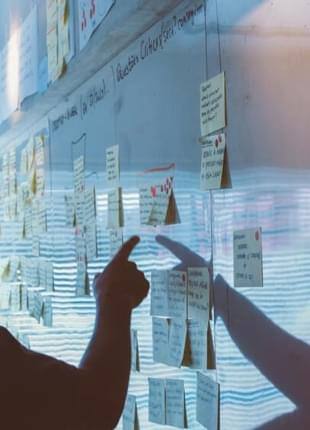“I don’t like it”
Despite the fact that I can barely remember the last time I heard these words, they can still strike fear into the heart of any designer. Firstly, no matter how detached and professional we may be, nobody likes to have their work criticised. Second, if the end result is going back to the drawing board, it means time and money: and people don’t appear to like wasting time and spending money.
And the really bad news is that it’s not always even as simple as that. If two or more individuals have differing views on a concept, how do we resolve that conflict? There’s no point going back the the aforementioned drawing board if we haven’t got an agreed direction to work on. And this isn’t necessarily a client v agency conflict (they are easy to resolve!) The disagreement can be all on one side.
These situations are rare, or at least they are rare in well-run organisations and agencies. But they can be disastrous. What follows are my own thoughts on how to ensure they don’t happen to you.
Prevention is better than cure
The first and most important message: don’t let conflict or disagreement happen in the first place. This isn’t achieved by simply being a nice person and hoping everybody gets along. It is the product of a process that has been consciously designed to ensure that conflict is as rare as possible.
At Kooba we pride ourselves on delivering projects that clients love, on time and on budget. That means our process has to be pretty watertight when it comes to ensuring that we stay on the rails. Here’s three ways in which we do just that:
- Involve the client early and often. Too much exposure to Mad Men might have some people believing that an agency works up a concept to completion and then reveals all at the final moment. Well - maybe in the 50s that worked. Today not so much. We let clients have a feel for where the project is going from the proposal onwards. We’re happy to take feedback. The work is collective, we work through milestones so there are no surprises, and little conflict as a result.
- Focus on business objectives. We like to ensure we understand business objectives early, and we also like to ensure the client views the project from that perspective. In the absence of clear and objective goals for a project, it is all too easy to fall back on “make it look nice” as a sole criterion of success. And as what looks ‘nice’ is subjective, this invites disagreement and conflict. Keep the whole team focused on objective success and you are far more likely to get into that situation.
- Deliver a single concept. There’s an old theory in child development that giving toddlers a choice is rarely a good idea. Now I’m not comparing clients to small children, but it’s absolutely true that showing multiple concepts just invites anyone involved in the project to pick a side. Once that happens it’s hard to rewind and get back onto the same page. You can read more on our blog on the logic behind delivering a single concept, and the process you’ll need to follow to make it happen
All that said, there are times when despite our best efforts genuine creative disagreement can threaten a successful project. Fortunately, all is not lost.
Five ways to Resolve creative conflict
Just for the sake of clarity I will say it again: do everything you can to avoid getting into this situation! But if you DO find yourself struggling to create union where there is discord, here are five simple rules that will help get the project back on track.
- Take The Heat Out Of The Situation. Always take care to avoid letting emotions get in the way of a constructive conversation. Remember that everyone around the table is entitled to an opinion, and entitled to change their mind. Focus any criticism on ideas and designs rather than individuals. The latter might be tempting, but it really isn’t going to help!
- Go Back To The Beginning. As discussed above, anything that brings objectivity to the proceedings is helpful. Remind the group of the business objectives. Evaluate competing approaches against these objectives. Consider user testing - which brings the opinions of potential clients and audience to the table - as a way to add additional perspective and help the group move beyond entrenched positions.
- Ask Questions, Listen Clearly, Speak Clearly. As in life, so in the delivery of web projects: start with the assumption that you have the wrong end of the stick. If a client is digging in, ask questions and process the answers those questions in good faith. In cases where everyone needs to move a little, make that easy to do. When you need to speak, be clear and keep your focus on the success of the client. Don’t fudge things just to move on.
- Focus On Positives And Find Agreement. It is easy to let small differences overshadow large areas of agreement, but it would be a mistake. Work outwards from agreement, get people saying ‘yes’, and establish a positive environment. Keep differences of opinion in perspective and make sure everyone understands they are getting almost everything they want.
- Compromise (Within Reason). It’s OK to let go of your own opinion if a client is insistent. What’s less OK is mushing multiple approaches together in an attempt to please everybody. Try to keep the conversation about workable alternatives, but be ready to compromise, and set an example to others that a willingness to do so might be the best thing for the ultimate objectives of the project.
If you follow these five rules you should find yourself making progress. And reminded that the job of a designer is as much about project management and managing multiple opinions as it is about putting pen to paper.








